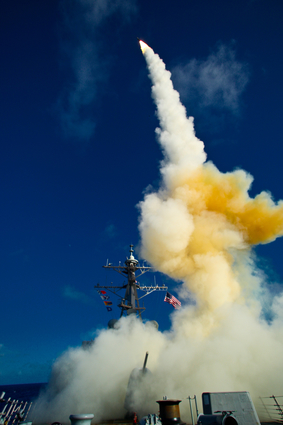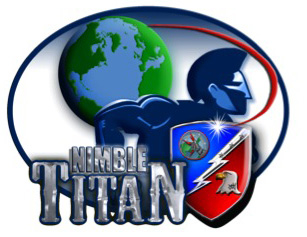Nimble Titan 12: an international missile defense exercise
Participants from 14 nations, and observers from such organizations as NATO, spent four days planning political, military, and civil defense responses to scenarios involving mock missile launches ten years in the future from fictitious countries named Seac and Rubicon.
Much of the background information on which the unclassified decision-making was based, came from ballistic missile defense (BMD) work undertaken at Lawrence Livermore National Laboratory (LLNL). Coordinated by the Lab's Mike Tobin, assigned to the Missile Defense Agency (MDA) in Washington, DC, Lawrence Livermore has been using its National Atmospheric Release Advisory Center and Advanced Simulation and Computing supercomputers to contribute vital and detailed information necessary for quick and well-informed decision-making on such critical issues.
"Once a missile is in flight, only a missile defense system can stop that missile from going off its flight path," said Col. Volker Samanns of Germany, as he kicked off the second day of the exercise.
"We have 40 or 35 or 20 minutes to get to something. No negotiation tables, no lawyers, no United Nations will change physics. So we have to act mindful of the time constraints of physics. That's the nature of ballistic missile defense issues," he said.
The exercise, named Nimble Titan 12, dealt with three BMD issues:
- Consultation: How can nations respond in a cohesive manner if an unfriendly regime warns of an upcoming missile launch, such as the case of last week's North Korean launch? Should discussions be carried out jointly, publically or quietly, among allies or third parties that could be friendly to the aggressive nation?
- Military response: Known as Offense-Defense Integration (ODI), participants take into account their potential military capabilities, either to deter the aggressor, or to support an ally's operations. Only unclassified military methodologies were considered.
- What happens immediately following an enemy launch? Defensive forces can try to intercept the enemy's missile, but numerous consequences can result from what is known as Consequences of Engagement (COE). Is the warhead nuclear, chemical, or does it contain bio-warfare agents? If the airborne enemy missile is destroyed, where will the resultant debris/surviving submunitions hit the ground and with what effect? What happens if the enemy missile penetrates the defenses? How do authorities warn the civilian population to shelter in a timely manner to avoid massive casualties? Tobin has been leading a NATO Working Group that includes the Czech Republic, Turkey, France, Germany, the United Kingdom, the Netherlands, as well as the United States, addressing this final aspect for the past four years. He was asked to address Nimble Titan's 200 participants and share some of his working group's findings.
Calculations by the Lab's Brenda Pobanz of the National Atmospheric Release Advisory Center predicted the airborne dangers of nuclear fallout and the devastation of a ground nuclear detonation that could face populations in an impacted area.
Global Security's Greg Dipeso assisted in predictions of nuclear yield and electromagnetic pulse (EMP), while Engineering's Mike Bland evaluated the EMP effects on civilian infrastructure. The threat to low earth orbit satellites from X-rays was also noted.
As was demonstrated during the mid-April lead up to North Korea's missile launch, efforts at diplomacy to thwart such an event can be difficult and sometimes non-productive. Complicating the matter is that NATO, for example, requires absolute unanimity in its actions; even just one of its 28 member countries can veto any proposal.
Furthermore, as became evident during the Nimble Titan exercise, countries considering each other as allies can sometimes be hobbled by their own constitutional obligations. For example, Japan - despite being a key friend of the West - is not permitted to intercept a ballistic missile that is targeting an ally because its constitution limits Japan to defending only its own territory.
The Laboratory's Missile Defense Program actively supports the Pentagon's Missile Defense Agency mission in many areas beyond those detailed by the Lab's Tobin during the missile exercise. These projects include support to MDA's missile defense battle modeling and simulation, developing missile defense threat information, providing kinetic intercept lethality predictions, conducting directed energy research, and supporting MDA nuclear survivability needs using NIF survivability experiments.
Military planners generally agree that the most efficient defense against an enemy's ballistic missile launch is to intercept and destroy it at the earliest possible time. This is considered to be while the rocket is still in its "boost" phase, namely, shortly after liftoff, while the first stage of its stages is still providing most of its thrust. This is the eventual goal of the Lab's research of the Diode Pumped Alkali Laser (DPAL), carried out in the National Ignition Facility and Photon Sciences directorate.
According to the director of MDA, Lieutenant General Patrick O'Reilly, the area of directed energy is one of the most important capabilities for the future support of the nation's Ballistic Missile Defense System (BMDS).
Efforts are also underway to safeguard civilians.
There may be a few to tens of minutes' warning time between the launch of an enemy's ballistic missile and the onset of consequences.
Khan Jahier, on the staff of NATO's Civil Protection Group, said, "With today's technology, it is possible to issue a call-to-shelter to a civilian population rapidly. These technologies might leverage SMS (cell phone broadcasting) and other non-traditional communications paths."
According to Khan, "Studies have shown that a warning to the population before a ballistic missile impact on the ground could reduce the number of casualties by up to 70 percent, and the act of sheltering in place can be up to 500 times safer than staying outside."
On the exercise's final day, Commander Jeroen De Jonge, of the Royal Netherlands Navy, expressed his satisfaction, saying, "I think that Nimble Titan is important for the participating nations in trying to identify some of the BMD issues and trying to understand each other's positions, to try to get a clearer view on the internal domestic political ramifications, considerations that nations might have regarding BMD. It's also important because this is not a foreign policy setting. This is a war game, a workshop environment that enables participants to get to know each other, to learn from each other, take those lessons home, and apply those lessons in their own foreign policy establishment's position-taking in the future."
Contact
Robert H Hirschfeld[email protected]
925-422-2379
Tags
Strategic DeterrenceFeatured Articles










